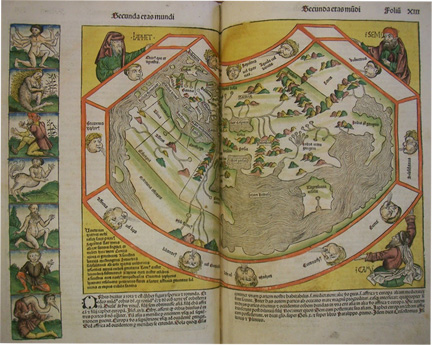What's in a map?
A map organizes information in space. All maps represent the creator's world view, what they think most important and what defines its relationship to other objects, both physically and conceptually. Maps, in this sense, can be both pictorial or verbal representations of a intelligent and intelligible organization of the world. Our satellite maps and geographic maps present the claim that the world is best understood as a series of mathematical relationships. Perhaps it is. In the past, however, those mathematical relationships were only one part of the equation.

This world map from the fifteenth-century Nuremberg Chronicle (Drew Incunabula 21) is only partly interested in representing space as a set of mathematical relationships. This map is also interested in representing space as both a biblical reality (see Noah's sons bordering the map), a climatic reality (see the various winds) that contributed to the formation of character and human type (see the antipodal figures at left). In this manner it represents a particularly fifteenth-century manner of viewing the world.
Mapping as a tool of analysis
Mapping historic verbal or pictorial descriptions of space into mathematical relationship between spaces reveals how the historical author understood their world to be organized. Mapping offers the historian a different tool to analyze what space meant. The Medieval Mediterranean Map and the other maps presented on this site organize texts (poems, chronicles, travel narratives, etc.) and images (representations of space, artistic works, pictures of buildings) into a geographic database to allow the user to consider the meanings of space, and of the objects or texts within that space.
Some classic examples in topology:
The Seven Bridges of Konigsberg (not all combinations of objects in space are possible)
W.R. Hamilton and the Traveling Salesman (does efficiency determine the pattern of points?)